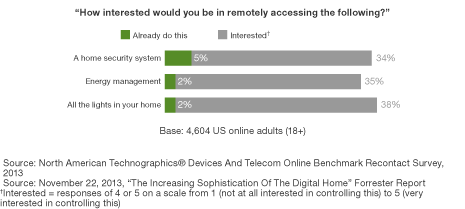The Data Digest: The Future Hits Home
When Ellen DeGeneres shined her spotlight on Nest’s “learning thermostat,” she was only foreshadowing the attention that the smart home device maker would soon receive. Google’s recent decision to acquire Nest Labs has sparked questions in the marketplace ranging from privacy concerns to marketing implications and everything in between.
But with these questions comes a recognition that the once-imagined future is less distant than we may think. A digitally enabled household no longer means simply maintaining a personal Internet connection or even syncing portable devices to a home network. Now, the digital home is becoming a conscious home — one that adapts and responds according to our behavior.
Cutting-edge devices like the smart thermostat might be low on the adoption curve today, but consumer appetite is evident. Forrester’s Consumer Technographics® data shows that more than a third of US online adults are interested in using technology to remotely control their home’s lighting, energy, and security:

The poet Emily Dickinson once said “Where thou art — that is home,” and, in some ways, her statement is far more futuristic than she intended. As smart devices increasingly become part of the furniture (no pun intended), individuals will have the capacity to connect with their houses regardless of location. In her recent report, my colleague Gina Fleming predicts that, ultimately, “the digital home won’t be a location but an individual, who will become the connector across different devices.” The number of these everyday devices will continue to grow — and will continue to connect consumers across time and place.
